 Iran’s Attack on Israel
Iran’s Attack on Israel


12 min read
African American women of the 6888th Battalion delivered millions of pieces of mail during World War II.
“No mail, low morale.” That was the slogan of one of the most remarkable military battalions to serve during the Second World War. At a time when the US Army was rigorously segregated, and when Black soldiers and female soldiers were barred from virtually all important roles, a remarkable battalion of 855 African American servicewomen was given a crucial job: clear a chaotic backlog of tens of millions of pieces of mail that was lying unorganized in rodent-infested buildings, and allow American troops to receive morale-boosting letters from home for the first time in months.
The “Six Triple Eight” – its official name was the 6888th Central Postal Directory Battalion – was given just six months to complete this mammoth job. Working in the midst of bombing and fighting in England and northern France, they completed their job in half the time.
A few years earlier, the thought that hundreds of Black women wearing the uniform of the US Army and operating in a warzone would have seemed ludicrous. Even though the US Army had a female “Nurse Corps” since 1901, the women who served in it didn’t have the same rank, pay or benefits as male soldiers.
That changed in 1941 when Representative Edith Rogers, the 6th American woman to serve in the US Congress and the first to be elected from Massachusetts, introduced legislation allowing women to join the US Army. She had the support of General George Marshall, the US Army’s Chief of Staff. After Pearl Harbor, he wrote to Congress stressing the need to recruit women quickly to help support the war effort: “It is important that as quickly as possible we have a declared national policy in this matter… Women certainly must be employed in the overall effort of this nation.”
President Roosevelt signed legislation a few months later creating the Women’s Auxiliary Army Corps (WAAC), allowing up to 150,000 women to enlist. Their role would be limited to “essential services” such as cooking and clerical work. They would receive room and board and pay but they wouldn’t have some of the benefits male service members enjoyed, including health and life insurance and prisoner of war status in the case of being captured. Despite these limitations, women clamored to join the WAAC: over 30,000 applied to join the first officer training class of 440 volunteers.
Remarkably, given the rampant discrimination in the US Army at the time, fully 10% of the WAAC was reserved for Black women – reflecting the share of the US population that was Black at the time. That was partly due to lobbying efforts by Mary McLeod Bethune, the founder of the National Council for Negro Women, and a passionate advocate for the advancement of Black women in American society. Once the green light was given for Black women to join the WAAC, Mrs. Bethune went to work recruiting women to join, placing ads in Black newspapers and sending mailings to women living in African American neighborhoods.
Private First Class Elizabeth Barker Johnson was working as a housekeeper when she saw a pamphlet for the WAAC on her doorstep in Elkin, North Carolina. “There was a picture of Uncle Sam on the pamphlet,” she recalled, “and he was pointing a finger. It said, ‘Uncle Sam wants you.’ So I picked it up and looked at it. I read some of the information and after I’d finished reading, I said, ‘Well, maybe you just got me.’” Pvt. Johnson became one of over 6,500 African American women to join the WAAC, and ultimately worked in the Six Triple Eight.
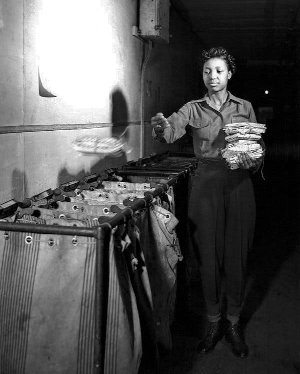 Cpl. Annie Braceful sorting mail.Credit...
Cpl. Annie Braceful sorting mail.Credit...
While most of these women were of enlisted ranks, two Black women became Majors during World War II. The first to achieve that office was Maj. Charity Adams (later Earley), who would go on to lead the Six Triple Eight Unit. Her drive to prove herself and to expand opportunities for Black American women wound up contributing enormously to the Allied war effort.
When the WAAC was created, Maj. Charity Adams was a 23-year-old high school math teacher working in South Carolina. Unusual for many Black women in the American south at the time, she’d had the chance to go to college, studying math and physics, and was also studying part time for a graduate degree in Psychology. She enlisted in 1942 and was sent to Fort Des Moines in Iowa as a member of the first WAAC Training Center and Officer Candidate School. The site was historically significant: in 1917, during World War I, Fort Des Moines was the site of the first officer training center in the US Army for Black servicemen.
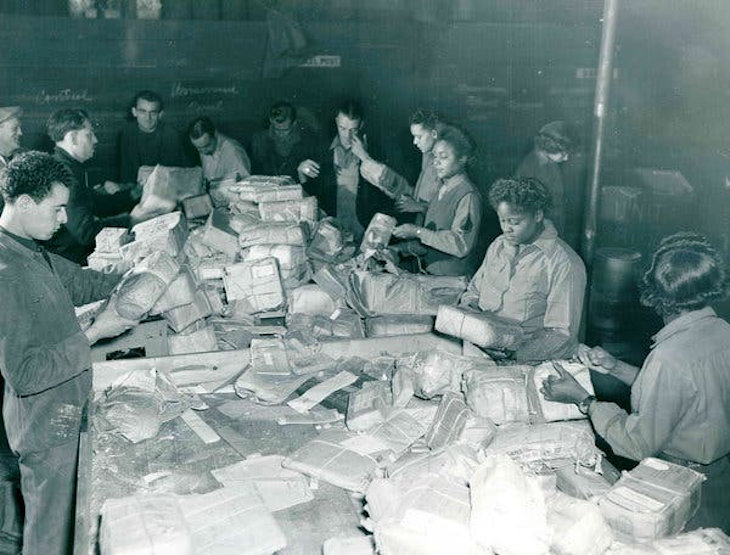 The Six Triple Eight and civilian postal employees sorting mail in France in November 1945, two months after the war ended.
The Six Triple Eight and civilian postal employees sorting mail in France in November 1945, two months after the war ended.
Even though the women officer candidates had developed a camaraderie on the journey to Fort Des Moines, institutional racism soon divided the soldiers. After their first meal together, the officer candidates assembled in a reception area, where a young second lieutenant ordered all the “colored girls” to move to one side. The soldiers were shocked, but the few African American soldiers who were present duly complied. For a time in Des Moines, the Black soldiers ate and slept in separate quarters from their white colleagues. Mary McLeod Bethune intervened and called on her influential friends for help, including First Lady Eleanor Roosevelt. The WAAC officer training program was finally integrated, one of the only integrated spaces in the entire US Armed Forces at the time.
Life wasn’t easy for the WAAC servicewomen. Army Military Intelligence had to investigate malicious rumors spread by male soldiers that WAAC soldiers were loose women of ill repute (they found nothing of the sort). For Black soldiers, life was even more difficult: white women were given the most appealing jobs; Black recruits were often left with menial and cleaning jobs to do, even when they were more qualified than their white counterparts. That began to change somewhat in 1943 when pressing military shortages spurred President Roosevelt to upgrade the WAAC to the Women’s Army Corps (WAC), which gave female soldiers military ranks on a par with men.
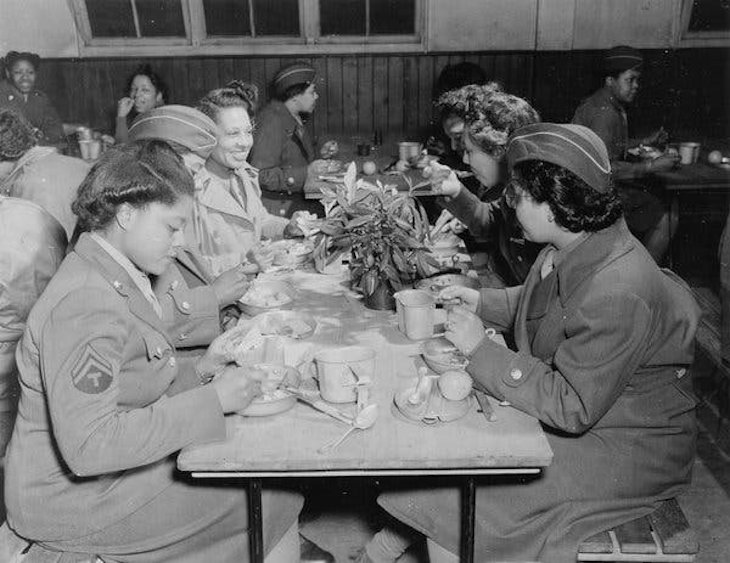 Members of the Six Triple Eight at a mess hall in England.
Members of the Six Triple Eight at a mess hall in England.
By then, Maj. Charity Adams was in charge of training Black recruits at Fort Des Moines. She pushed for greater opportunities for Black female soldiers and oversaw the development of the first Black women’s band in US army history. Developing the band wasn’t easy, and Maj. Adams fought both entrenched sexism and racism within the army at every turn. With the all-female, all-African American military band up and running and a huge success, other officers noted that Maj. Adams was a woman who could cut through red tape and get things done. Soon she’d be tasked with work that was even more consequential to the war effort.
On December 16, German forces launched a major offensive aimed at halting the Allies’ advance to retake Western Europe, in what became known as the Battle of Bulge. Over 80,000 Allied soldiers died. Fighting was fierce and military commanders realized it was crucial to keep soldiers’ morale up. Yet there was a huge problem: the US Military’s postal system had been in disarray for years. For two years, many soldiers hadn’t received any letters or packages from home and the problem was getting worse. The lack of mail from loved ones was lowering morale.
It was time to bring in someone to reorganize the entire mail system in the European war theater, someone who was used to getting things done and wouldn’t let difficult circumstances stand in their way. Someone a lot like Maj. Adams, a woman who’d been battling sexism and racism her entire life – and won.
 Maj. Charity Adams and Capt. Abbie N. Campbell inspect the first African-American members of the WAC, somewhere in England.
Maj. Charity Adams and Capt. Abbie N. Campbell inspect the first African-American members of the WAC, somewhere in England.
In January 1945, Maj. Adams was ordered to board a cargo plane bound for England on a classified mission: she was given a letter with the word “Secret” stamped on it and told to open it only once she was in the air. At 26, she was the first Black Female commanding officer in the US military to be deployed in a theater of war. Her orders only told her to report for duty at a military outpost in Birmingham, England.
There, on the outskirts of the much-bombed city, a bizarre sight greeted her. In the empty airplane hangars were mountains of letters and packages in complete disarray and infested with rodents. Many of the items lacked complete addresses; many were missing soldiers’ serial numbers, which were required in order to deliver mail. Thousands of the letters contained duplicate names. (For instance, there were over 7,500 soldiers named Robert Smith serving in Europe.)
In the end, Maj. Adams and her battalion would distribute over 17 million pieces of mail. It was a gargantuan task.
As Maj. Adams gazed at the mess, a battalion of Black American servicewomen was en route to handle the mail and eliminate the backlog under her command. The group, which eventually numbered 855 soldiers, was given six months to complete the job.
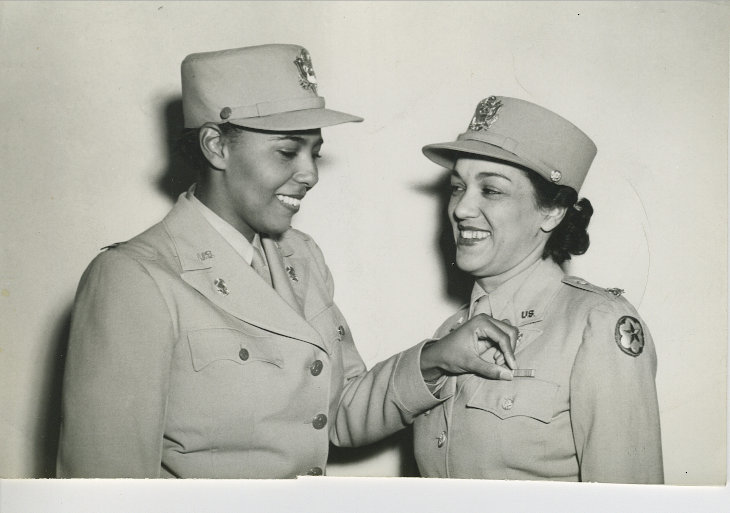 Maj. Adams, left
Maj. Adams, left
The servicewomen came by ship: an eleven day journey during which they were shot at by German U-boats and narrowly escaped being torpedoed. When the soldiers finally arrived in Birmingham they were exhausted but thrilled to be making history. They were now the 6888th Central Postal Directory Battalion, the only African American female battalion deployed overseas, and they began work immediately.
Maj. Adams divided her battalion into five companies working a rotation of three shifts. Working round the clock, seven days a week, a third of the women sorted mail at a time, while a third slept and a third did other work on the base. Their accommodations were Spartan; they slept in an abandoned school building with no heat, and the airport hangars they worked in had poor lighting and ventilation. Birmingham was bombed heavily by Nazi troops and work was often interrupted by air raids. The soldiers quickly came up with novel bookkeeping systems to keep track of seven million soldiers across Europe. They pieced together incomplete addresses, cross checked soldiers’ names on databases, and returned mail to families of soldiers who’d been killed in action. Soon, the Six Triple Eight was the fastest and most efficient mail depot in the entire European theater, processing millions of letters and packages in just a few weeks.
Racism and sexism were never far away. When an American general turned up at the airfield one day to visit, all available personnel assembled to greet him. Enraged that more soldiers didn’t assemble, the general complained to Maj. Adams. When she explained that according to her strict schedule one third of her soldiers had to be working in the mail rooms and one third must be sleeping at any given time, the general responded, “I’m going to send a white first lieutenant down here to show you how to run this unit.” Maj. Adams replied, “Over my dead body, sir.” The general accused her of insubordination and even began court-martial paperwork to have Maj. Adams prosecuted, but later dropped the case.
Maj. Adams also stood up to racist officials at the American Red Cross Club. Black servicewomen weren’t allowed to enter the Red Cross’ military social clubs, and when the American Red Cross Club arranged for a getaway for American servicewomen stationed in England to visit London for a few days, they insisted that the Black soldiers of the Six Triple Eight Battalion stay in a separate hotel that would have only Black clientele. Maj. Adams refused their offer and made her own arrangements; her servicewomen did visit London, but they stayed in ordinary hotels like any other guests.
Local English people in and around Birmingham were much friendlier and often invited the women of the 6888th Battalion over for tea. Denied entry to the US Army’s social clubs, the Six Triple Eight soldiers forged friendships with British civilian families instead.
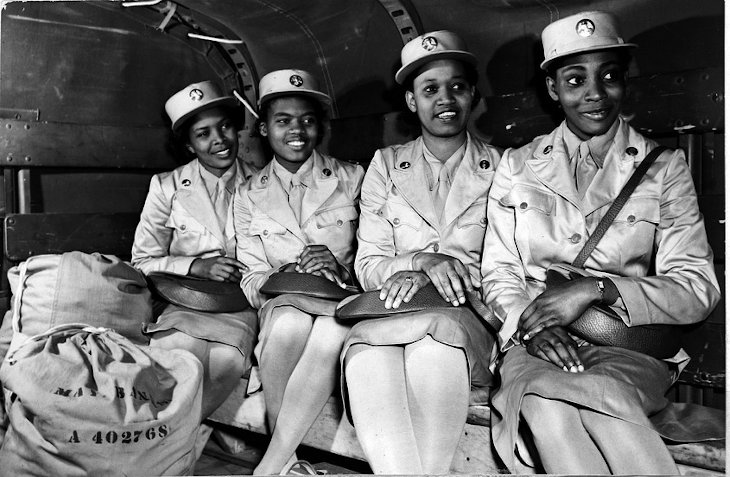
They completed their task to clear the 17 million pieces of mail in three months. In June 1945, after the surrender of Germany, the Six Triple Eight was transferred to Rouen, France, to sort out a backlog of US military mail there. In October 1945 they moved on to Paris to oversee the distribution of mail from there to troops. They finished their assignment and returned home to the US in March 1946.
The servicewomen of the Six Triple Eight received no formal recognition of their work and little thanks. One surviving service member recently recalled, “We were never made to feel like anything we’d done was special… We just went home to our families.” In 2019 the US Army belatedly awarded the Six Triple Eight the Meritorious Unit Commendation.
Maj. Adams stayed in the Army for a time, becoming the first African American woman Lieutenant Colonel in the US Army. She later returned to civilian life, went back to graduate school, married, and worked at the Veterans Administration as a college dean. She also became a tireless advocate for civil rights in Dayton, Ohio, where she and her husband Dr. Stanley Earley Jr., settled. When she died in 2002, her children requested a military honor guard to honor her years as an officer in the US Army – the Army at first turned them down, and only reversed their decision when some high ranking old timers remembered her path-breaking service.
Maj. Adams’ leadership – and the work of the hundreds of soldiers in the Six Triple Eight, succeeded in keeping up American morale during some of the darkest hours of World War II. Their legacy deserves to be remembered.
